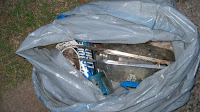When I entered
Caprock Canyons State Park, I wasn't prepared for all this park had to offer. I saw: more wild animals than I'd ever seen in one day at a state park; a beautiful lake; and breathtaking canyons and rock formations. I met a group of horseback riders near the "Little Red Tent" primitive camping area. Their picture is below.


There's a five mile scenic tour of the canyon; my husband (my driver) and I took pictures of bison on the way. It was exciting to be in the car with huge bison outside roaming around unpenned. They weigh up to 2000 pounds.The park is fenced and there are cattle crossing rails to keep them inside. But, with my vivid imagination, I could have been on a stagecoach in the 1800's, traveling across this rough country with views of bison possible with every turn of the road. Without the generosity of Charles and Mary Ann Goodnight, who donated bison many years ago to save the species that was on the road to becoming extinct, the awesome animals I saw wouldn't be alive today. They're called the "Official Texas State Bison Herd". Seeing the large herds, I was grateful for this gift and the park staff's decision to let the animals run free, just as they would have been viewed many years ago. When talking to Park Interpreter LeAnn Pigg, I learned that there are approximately 125 of these animals in the park and the population has increased by 25 in the last year. What great news!

I also learned about Aoudad sheep, an elusive species found high in the mountainous rocky areas of Caprock Canyons. Aoudad were brought to Texas from North Africa in the 1950's, escaped the fenced areas they were kept in, and now live in areas that are high and dry. The park's store sells a postcard with a picture of them taken at Eagle's Point in the park.
Another animal easily seen within the borders of the park are prairie dogs. They can be seen coming out of their burrows or running back and forth in their daily routines.
There are two lakes in the park. Lake Theo, the larger lake, looked inviting until I put my hand in the chilly water. Fish were jumping in the swimming area behind the "No Fishing" sign. Fishing is allowed in other areas. Dry Creek Lake is the smaller lake in the park. I was unable to see it on this trip but a ranger informed me that it does have water in it, despite being called dry creek. The water was quite a bit lower than Lake Theo, according to this ranger.
I forgot to pick up trash while at Caprock Canyons. In the time I meant to be doing my trash duty, I took a second drive to view the bison. It was worth the trip. The park was clean; I would have had to search the bushes to find enough for a photo of trash. That's what I do in most of the state parks. Our park workers and volunteers deserve a "Thank you" for keeping the parks cleaner than most city streets.
I plan to visit this park again since I could only stay for a day. There wasn't enough time to even fully explore a few trails. For the real hiker (not me), there are 64 miles of trails to walk along. I'd like to get a glimpse of the Aoudad sheep or the American Kestrel hawk, which also can be seen at Caprock Canyons. The lakes would beckon me back for fishing and swimming...in the warmer months.
w |
|
 |
The rock formations alone are worth the trip to this park (above) and Lake Theo was lovely. After viewing the park, I rested under a tree near the lake.
Fall is a great time of year for hanging out in state parks; quiet and cool. This was before Halloween (obvious from the pumpkins next to the park sign). I look forward to writing about another park adventure next month.
|








































